Would you like the ability to control when your image is or is not captured by facial recognition software?
Many Americans feel abuse of this technology routinely violates either the God-given or constitutional rights of US citizens.
Facial recognition software enables the image of a subject to be identified by assigning values for the relative proportions of aspects of the subject’s face, and then comparing to databases of values for the faces of individuals whose identity is known, such as databases of passports, military ID’s, driver’s licenses, law enforcement databases, year books, school records and so on.
Newer technologies employ three-dimensional information about the shape of a face and skin texture analysis. This information can be misused to violate rights such as freedom of assembly, freedom of movement and, some believe, can constitute unlawful search and seizure or other rights violations.
Rights and Property Predate Law
Law was created in order to protect rights and property, but is now all too often used to legally plunder them.
Professor Alessandro Acquisti conducted a series of experiments at Carnegie Mellon University (CMU) which identified strangers, identified their personal information and, in some cases, even social security numbers and credit reports. The experiments were both on-line and off-line and used only photos, social media and resources available to end users.
He demonstrated the ability at the BlackHat security conference in Las Vegas … five years ago in 2011!
Think this technology is only available to the government and highly paid private investigators? Unfortunately, it’s attainable by pretty much anyone who knows how to read and has the will and a smartphone. CMU even developed an app that overlays personal information on an image of the person’s face.
I don’t think the fact that facial recognition software and social media increase privacy risks is a new idea to most people, but I think that the seriousness of their personal exposure often is. People tell me all the time that they don’t like to think about privacy, and global surveys bear out the fact that people tend to ignore known cybersecurity risks the world over.
Does your own normalcy bias extend to social media?
Is privacy a factor when you choose smartphone apps?
Do you manage your on-line data footprint?
How easy would it be to identify you using facial recognition?
I’m not talking about the government, police or tech nerds wearing products like Google Glass here. I’m talking about anybody with the will and a smartphone being able to not only identify you, but access your personal or sensitive information.
I’m sure most of you do not lay awake nights worrying about whether it is possible to identify you through facial recognition, but could you successfully avoid facial recognition if you determined you had a need to do so?
Many preppers find it useful to consider “what if” scenarios involving grid-down, WROL (Without Rule of Law) scenarios in the theoretical vacuum of a technology-free world. Placing theoretical boundaries on survival scenarios is fine for recreational daydreaming, but less effective as an aid to serious preparation. With the sheer number of cameras in circulation, some will likely still be working in the majority of scenarios.
A reversible hat, two or more hats of different colors and designs may enable you to quickly change your appearance enough to escape detection by someone with a verbal description of you.
Hats, long-sleeved shirts, hoodies, reversible jackets, sunglasses, umbrellas, newspapers and gloves are all tools that aid in masking physical characteristics, enabling you to stand out less if you have to travel through, as area where you may be perceived as an outsider or wish to remain anonymous, on or off camera.
1. Camera Finders
Cameras can sometimes be detected and avoided if you see them before they see you, or if you know where they are ahead of time. Then they can be neutralized with something as simple as a disguise, a tilt of the head or placement of an opaque object between you and the camera you wish to avoid.
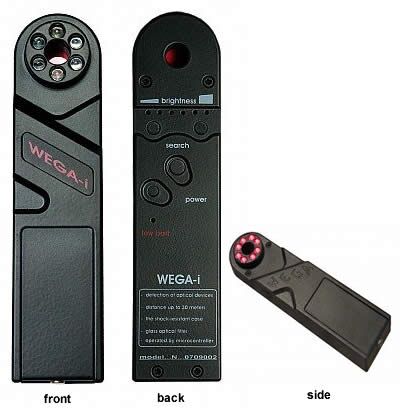
Camera finders would be more correctly called reflection or lens finders because they use light reflected off camera lenses to find hidden cameras.
These devices typically have a lens or filter that the operator looks through to sweep an area for cameras while the device projects light, which is reflected back by camera lenses and highlighted when the operator looks through the camera finder’s lens or filter which matches the color of light.
Some devices employ magnified lenses and can aid in the detection of cameras at 6′-30′ distance. Some operate in the NIR range so you don’t have to darken the room in order for the device to be effective.
Alternatively, you could use a wireless camera finder, but they only find wireless cameras that are transmitting. You could use a glint finder, but they are really designed to find a camera with a flash by illuminating the retro-reflective material in the flash element, but they can sometimes aid in finding a lens.
Or you could try a glint finder app. They attempt to employ your smartphone LED as a glint finder, but I yet to see one that I would describe as effective.
Pro’s
- Compact.
- Helps you find cameras to up your situational awareness, improve your security and better avoid them.
- Works on cameras whether they are on or not.
- A simple version of this tools can be improvised out of materials you probably have laying around the house or could buy at a Walmart if you enjoy the thought of hastening the US economy along its charted course. Not one of your many skills? Pull up an Instructable or “How To” article on-line.
Con’s
- Won’t find a camera if it is hidden behind a reflective surface like a one-way mirror, so you should inspect any reflective surfaces to make sure they are one-way and don’t have any pinholes.
- Only identifies cameras as opposed to “tricking” facial recognition software.
- The process of sweeping for cameras will seem strange under most circumstances if done in public.
- Today, cameras have lenses, but innovators are working hard on lens-less camera designs that would not be able to be detected by this technology.
- Quality varies.
2. Clothing and Accessories with NIR LEDs
These products use bright NIR LEDs to overload the light sensors on a digital cameras resulting in unusable images.
According to Kit Eaton at FastCompany, if you wear clothing or accessories that protect your privacy, you are “cartoonishly paranoid.” But manufacturers do not seem to be bothered by liberal media naysayers and are making clothing and accessories with features like NIR LEDs to defeat surveillance and facial recognition cameras.

Pro’s
- Some are not overtly visible to the naked eye.
- Can be integrated into clothing and accessories.
- Can be a DIY project.
Con’s
- Very obvious on camera that you are using the technology.
- It hides your face as opposed to “tricking” the camera that you are someone else.
- Writers might call you names.
3. Retro-reflective Clothing and Accessories
Wearing clothing that has even a couple of inches of surface area that is retro-reflective makes it trivially easy for anyone with a flashlight or night vision with an IR illuminator to find you in the dark, but it can also blind cameras in much the same way that NIR LEDs do.
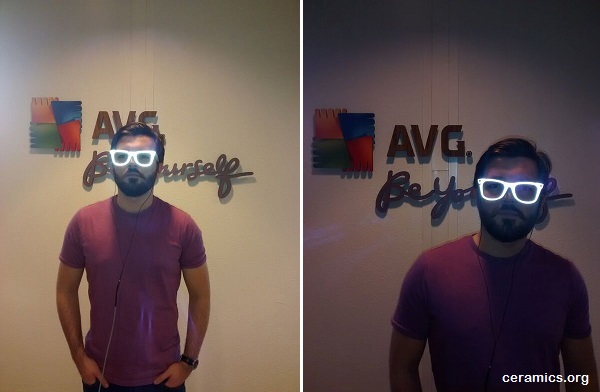
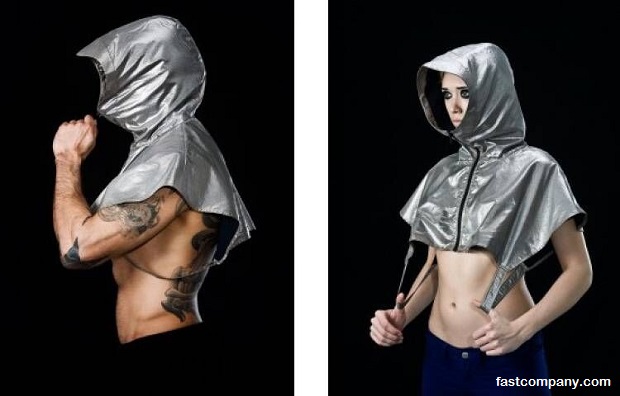
Pro’s
- Not necessarily overtly visible to the naked eye.
- Good for night signaling in an emergency.
- Good for roadside safety.
Con’s
- Users stand out to searchlights at night.
- Very obvious on camera that you are using the technology.
- It hides your face as opposed to “tricking” the camera that you are someone else.
4. URME Prosthetic Mask
This high quality prosthetic mask of the face of privacy activist Leo Selvaggio is not your typical Halloween mask.
The name is pronounced “U-R-Me” and I believe the mask started on Indiegogo and may still be available on ThatsMyFace.com. The mask fools Facebook’s facial recognition software and are sold at cost because Selvaggio believes that everyone has the right to privacy.
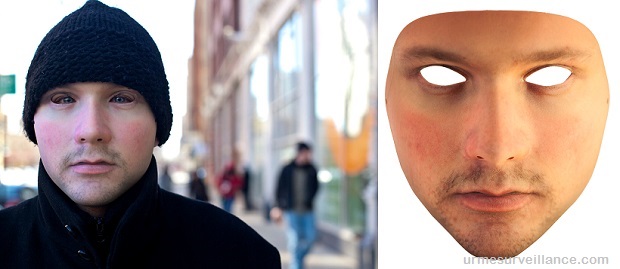
Pro’s
- Convenient.
- Quick change.
- High quality.
Con’s
- Expensive at $400.
- “Why are you wearing a mask?”
- If someone stops you, and you speak, they will probably notice that your lips aren’t moving.
- Some software may eventually filter out this “face” unless masks of many more faces are made.
5. Hair & Makeup
By styling hair and wearing makeup in certain patterns, facial recognition can be fooled.
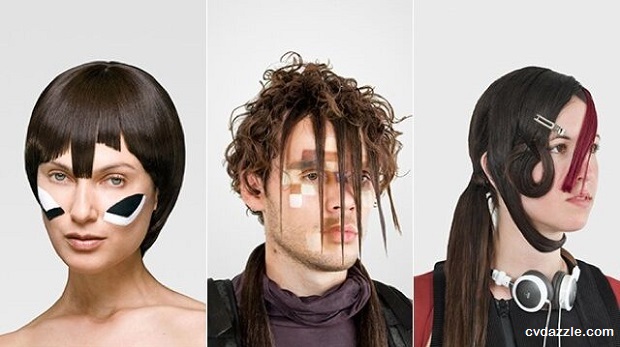
If you are going to apply camouflage makeup, why not incorporate a pattern that will fool facial recognition cameras?
Pro’s
-
Inexpensive.
-
Probably not going to motivate someone to call the police and report you.
- DIY.
Con’s
- May not work 100% of the time.
- “Why are you dressed like that?“
- Not quick or convenient to change your appearance.
6. Balaclava, Sunglasses & Hat
I always have one or more hats, some quality sunglasses and a balaclava in my EDC bag and use this method to protect my identity in photos I post to social media or when editors, radio shows or Expo’s want a head shot.
 One of my favorites is a no-drip, fire and flash-resistant flesh tone balaclava of DryMax material, but I have others I wear in cold weather or for specific purposes. I like the Shemaughlava by 782 Gear too and always have a large 100% cotton handkerchief or shemagh handy.
One of my favorites is a no-drip, fire and flash-resistant flesh tone balaclava of DryMax material, but I have others I wear in cold weather or for specific purposes. I like the Shemaughlava by 782 Gear too and always have a large 100% cotton handkerchief or shemagh handy.
The same tools can help protect you from exposure, protect your eyes or can help protect your identity if you have to do something you’re not proud of in a world full of cameras.
When things go sideways and the lights go out, I find comfort in reaching for low tech tools to solve the problems at hand and hats and balaclavas are just that.
If you use this method, be sure to cover as much of your face as possible. Object recognition does not use the covered portions of your face and some software can identify faces with as little as 30%-50% of the face unobstructed.
Pro’s
- Easy to explain why you carry it.
- Low tech.
- Multi-use.
- Inexpensive.
- Practical.
Con’s
- Hides you as opposed to “tricking” the camera.
- Will not work with thermal imaging unless you use materials designed to do so such as multi-spectral camouflage.



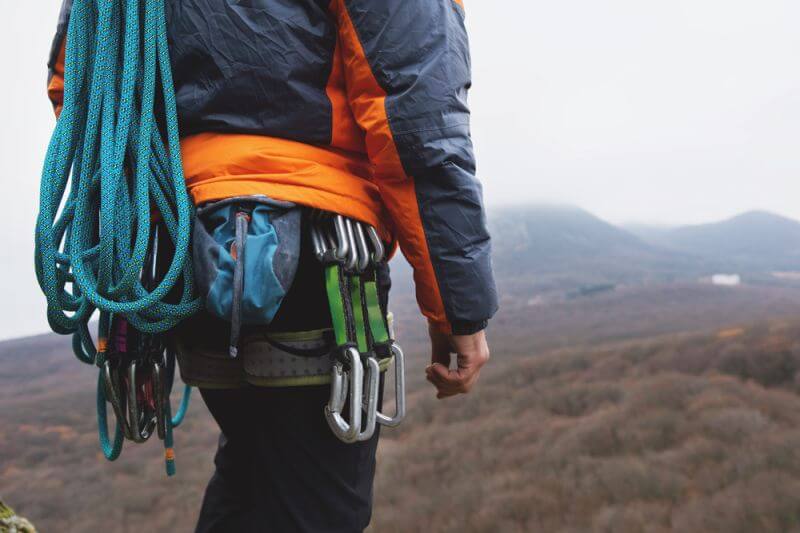


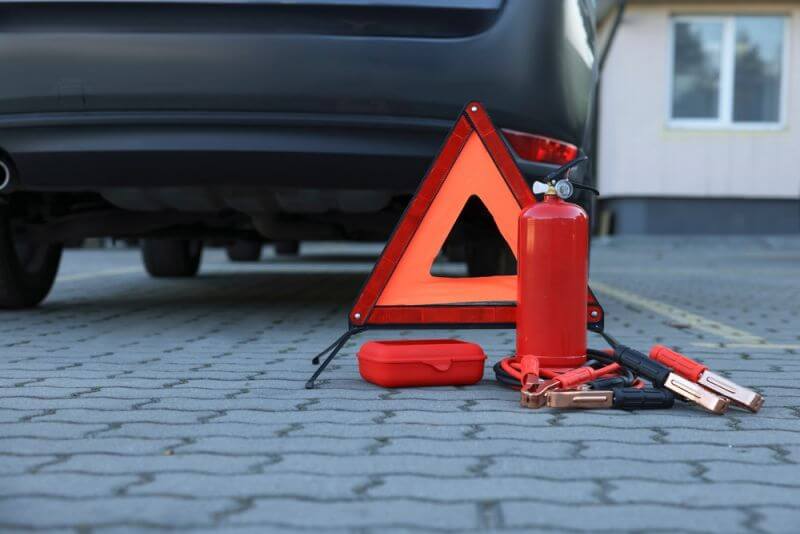

mud | April 22, 2016
|
“and even a burqa”
That is scary.
I’ve noticed, for at least 10 years, that a lot of Black young males seem to prefer wearing “hoodies” and/or sunglasses. Seems like they’re trying to hide from something.
A hoodie seems potentially dangerous to wear while driving though, as it blocks some peripheral vision.
[email protected] | January 4, 2017
|
Facial recognition is the worst, and is an absolute invasion of privacy. Constantly digi raped by digi systems I guess. How about the LED hat?
Ray | March 4, 2024
|
Our biometric data is our property and is being taken without our consent based on the presumption that we do not object. A security agreement can be created whuch creates a licensing agreement with the CEO thereby creating the notice of trespass with terms and conditions of using our property by paying a monthly or annual fee and if ignored assessing a penalty amount of xM dollars. The security agreement is recorded in the county along with an UCC1.
Mike | April 12, 2018
|
We wear hoodies because walking while black gets you at least, stopped and harassed and at worst shot dead by police. Funny thing is that you single out black males when as a matter of fact, hoodies are popular among young people in general.
connie | July 3, 2018
|
Also popular with old people. I own about 6 hoodies, and wear them regularly. I’m 62.
bob | July 3, 2018
|
From personal experience:
– Only young black males wear hoodies *with the purpose of covering their face*
– A person wearing a hoodie to cover their face can often be intimidating, no matter what race and age
– *people covering their face* are often harassed, not *black males*
So try walking *without a hoodie* for once, and try not to hide your face, and see if you really get harassed or interrogated.
Snowflake | August 1, 2018
|
I’ll agree that covering one’s features can be a cause for suspicion given the right circumstances, but you say a couple things that are not only incorrect, they show a clear bias against black people.
Black males are harassed all the time, wearing hoodies or not. Especially by police and business/property owners. There are social media posts and videos all over the internet showing street and public harassment. And if you were to ask a young black male (or really any black person in most places) they will tell you about their experiences being harassed because of their race.
I’m a white male, and I’ve worn hoodies with the express purpose of covering my face. I have social anxiety and I don’t want to be acknowledged or spoken to, and it often works for me — my whiteness makes it easier. And women who don’t want to be cat-called also cover their features to avoid street harassment, though it doesn’t always work. So it isn’t “only young back males” who cover their face.
I see what you’re saying, but underneath it all is a “your skin color is not a factor in your experience,” which is in direct contrast to what most black people have experienced. I recommend finding someone who is willing to share their experiences with you, so that you might find out more about what it’s really like being black in America.
Lovely | March 28, 2020
|
Everyone should see “Nosedive” on The Black Mirror, on Netflix. After seeing it, you may refect: Do I want to participate in this? Or opt out?
Mike | November 15, 2018
|
thank you officer!
Mac_S | June 10, 2019
|
Wow. I’m a white, law-abiding male, and I wear hoodies all the time because I don’t want digital big brother tracking my every move. That’s why this website is so great, isn’t it? I’ve never been harassed, in fact, people tend to leave me alone when I’m wearing a hoodie to remain anonymous. I’m sorry you’ve had such negative experiences with black males wearing hoodies, I truly am. I hope you can see past your own personal encounters and not pre-judge the next black male wearing a hoodie, because it may just be a regular person who is trying to protect his privacy like we all strive for in this age of insatiable government snooping (all in the name of “homeland security”).
ofra | August 28, 2019
|
Exactly! Why can’t they get it? Why aren’t they more concerned about it!
karla katz | December 28, 2022
|
Sorry, sugar, but as a young female, I always profile ANYONE wearing a hoodie to the degree that their facial features are hidden.
Richard Vert | January 3, 2019
|
I try to carry a screwdriver w/me at all times and if I spot a camera I ram that sucker through the lens and carry on . If EVERYBODY did the same they might get the message.
Charlie | May 12, 2019
|
They have as much a right to hide as you do, probably more of a legit reason to want to do so
mud | April 22, 2016
|
What about wearing an eyepatch made of one way reflective film?
I see “see-through mesh” ones being sold too. Would either fake out recognition software?
Cache Valley Prepper | May 7, 2016
|
Some software can identify a face with up to 50% of the face obstructed, so it may not work by itself, but it may if used in conjunction with other measures.
Gerry H Martin | April 23, 2016
|
I found this quite interesting. It certainly made me stop and think since I live alone and am past 65. I don’t consider myself old, but I think it is best to be realistic.
Brum | April 28, 2016
|
Can you explain what living alone at age 65 has to do with defeating Facial Recognition Cameras and software.
nobody | May 8, 2016
|
they can target him in SHTF to rob him if that facial reconition camera finds all his information online simple
Cache | September 7, 2016
|
In this context, it means the reader is aware that they are vulnerable. Embracing that fact can be a catalyst for implementing security measures.
The threat posed by facial recognition does not discriminate according to age.
Pingback:Watching Big Brother | Icliks Incoming | April 23, 2016
|
Pingback:"Et tu, Brutus?" Is Your Church An NSA Spy? | Survivopedia | May 17, 2016
|
rfresa | July 24, 2017
|
It seems like you could do a lot of simple tricks with hair and makeup that would look more “normal” to human eyes than the styles pictured here and still obscure or change your face enough to fool software. Long bangs or curls; a lot of fancy eyeshadow, rouge, and glitter that would just look like a tacky makeup job; applied moles, tattoos, facial hair, scars, rashes, or birthmarks; even sunscreen streaks, food smears, or running mascara would escape the notice of most observers as being deliberate disguises. Could a person use retro-reflective material as facial glitter? A bit faddish, but relatively unobtrusive.
Nyss | January 23, 2018
|
I’m not sure, they do have that makeup remover app now
Moi | May 17, 2019
|
Just wear a surgical mask, hat and sunglasses. Cheap, justifiable and effective.
Just Passing Through | June 22, 2019
|
Two things; one, covering your face with the balaclava method; whilst a balaclava alone won’t fool facial recognition (It just doesn’t; that’s a myth) the sunglasses-bally-hat approach will. And in the UK and many other countries the Police will just make you remove it for the camera. It’s a £90 fine in London – and that’s after they’ve taken it off you. The other; without ‘Liberals’ none of this anti-surveillance technology would exist. The clue is the word ‘Liberal.’ Dictionaries are handy things to own… and it’s the Right Wing, Republican backed corporations doing this to us all.
DP | July 7, 2019
|
Also they are storing your drivers license pictures to use for facial recognition so what could you wear for your drivers license pic to obstruct their game?
ofra | August 28, 2019
|
Well, in France they already fingerprint our passport allegedly to prevent theft. To a certain extent, it might help, but it is quite useful to the Police to have every one’s fingerprints on record. After all, it’s easier to catch a thief…
ofra | August 28, 2019
|
One day we may have a dictature instead of a democracy where the state will monitor and spy on its citizens to check every thing. Could also prevent some “troublesome” pro-democratic citizen or minorities from getting food and other shopping stuff. There is already something like that in China today. Not the prevention of shopping and access to food though… Very scary how people are dumb enough to fall for that one. It’s like everyone loves to be in brotherhood-watch society. Probably due to a sense of self popularity. Mark my word, the facial recognition is pretty dangerous… Let alone in the hands of the State or the Military.
jr | February 17, 2020
|
Some would argue that democracy doesn’t really exist at the moment: https://medium.com/enrique-dans/democracy-doesnt-exist-875c0fa25b81
Leo | April 4, 2020
|
This is a really cool article, thanks for writing!
Be careful with the NIR LEDs, if they are focused by your glasses lens into your retina (unlikely, but possible), they can burn the retina without triggering the blink reflex (because it’s not visible).
If all you’re worried about is AI facial recognition, not cameras in general, then the mentioned BlackMagic reflective fabric seems like the best option.
I can’t actually find that product though. Anyone know where I could buy it?
Kathy | May 19, 2021
|
I was hoping for something I could use in a more “practical” way. But I guess when it comes down to it, there’s no “real” way around it. Good going, Big Brother. I HAVE TO apply for unemployment or I could lose my benefits (health Insurance and food stamps). Part of the process REQUIRES facial recognition “because of the increase in fraud.” (Well yeh. quit giving out “free money.,” Big Brother.) So I’ll take it that the only way “around” this requirement is to not apply and take the chance of losing benefits. Boo.
CG | October 8, 2021
|
Throwing a patch on for an alleged eye injury probably wouldn’t hurt either with a wig. having longer bangs.